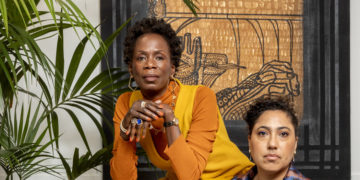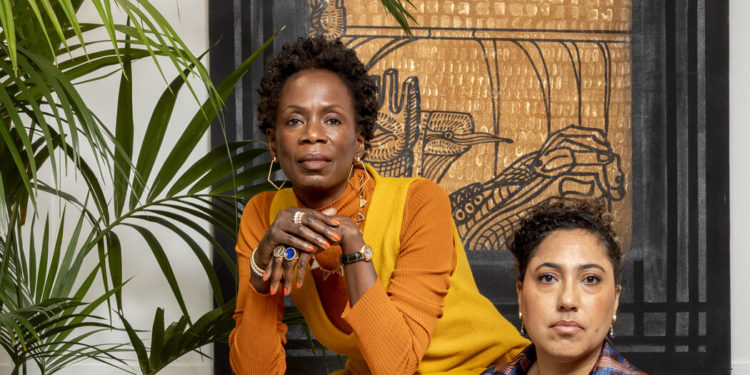The jewelry designer Lola Oladunjoye remembers that she was sketching in the studio of her Paris apartment one day in late May 2020. She looked up at the television and, on CNN, watched in horror a video of George Floyd being fatally restrained by a police officer in Minneapolis. It had been only a little more than two months since a police detective in Louisville, Ky., had shot and killed Breonna Taylor.
Shocked by these events, millions came out to march for racial equity in what may have been the largest protest movement in American history. It was a period that, for Black jewelry designers, became a bittersweet opportunity: A host of initiatives, curations and programs from brands like the Natural Diamond Council, Sotheby’s and De Beers were created to spotlight the work of Black designers in the aftermath.
And now, even as Black designers acknowledge a shift in the political environment, many say that the period allowed them to advance in ways they never expected.
Lorraine West, the founder of Lorraine West Jewelry in New York City, recalled that it took her 12 years to move into fine jewelry. Then almost overnight in 2020, she received an influx of orders and inquiries from retailers, fashion editors and corporate executives.
“Since then,” she wrote in an email, “I’ve learned to assess if an opportunity is in alignment with my business goals, building on a stable foundation of support, consistency, reciprocity and rest.”
The energy uplifting Black creatives had begun to fade by 2022, Johnny Nelson, the designer behind Johnny Nelson Jewelry in New York City, wrote in an email. But while the support for some brands has lessened, he added, others are now prepared for a longer, more sustainable journey. “I see a bright and abundant future for Black designers,” he wrote. “My wish is for us to create a strong network that shares resources.”
Mr. Nelson is now collaborating with the filmmaker Spike Lee on a limited-edition collection of nameplates and a custom four-finger ring celebrating characters that Mr. Lee has played. (And Mr. Nelson recently appeared, bedecked in his own jewelry, in a campaign for Sprite.)
Thelma West, who grew up in Lagos, Nigeria, and apprenticed in both Antwerp, Belgium, and the Hatton Garden area of London before opening her own design atelier and a gemological lab called IGR London, is philosophical about the current situation.
She remembers being the only Black person in her gem class; her goal now is to create and disrupt the industry with bolder pieces and louder messaging than ever before. “Ultimately this has been a wake-up call,” she wrote in an email. “We don’t need to wait for a ‘moment’ to shine. True talent has always been bright. The world’s just starting to catch up.”
An example of such advances is the Tiffany & Company x Council of Fashion Designers of America Jewelry Designer Award, a new prize created through diversity initiatives. The selection committee included Alexandre Arnault, Tiffany’s executive vice president of product and communications, and Frank Everett, the vice chairman of jewelry, Americas at Sotheby’s in New York.
The winner, Jameel Mohammed of Khiry, is to receive a $50,000 cash award and a one-year paid fellowship in Tiffany’s design department.
“I started Khiry when I was 19 and this is the clearest indication that there is future space for me,” Mr. Mohammed said after he was announced the winner on Jan. 15. “I’ve always wanted to work and design within a brand like this, which has international reach and resources, and, as an entrepreneur without a ton of capital and evaluating the landscape, I didn’t know what the next step was.
“I don’t have family money, and I want to make art in a fashion and design context. I’ve got a lot of ideas.”
The coming together of art and commerce seem to be at the heart of this new era. “I think economics is the core of any real change,” said Ebony Wiggins, the consulting director of equity initiatives at the CFDA. “There is no racial equity without economic equity, and this partnership allows that distribution of financial resources to be allocated to create societal progress as well.” She added that jewelry had the potential to reach the same prominence in society as women’s wear but that new pathways were needed.
Malyia McNaughton, a founder and the board president of the Black in Jewelry Coalition, is all about pathways and pipelines. The organization, formed in the summer of 2020 to advance Black professionals within the gem, jewelry and watch industries, now has several programs, including its award-winning Future Jewelers Academy that helps high school students gain experience by working at jewelers’ benches.
A jeweler herself, Ms. McNaughton said she believed that lasting change required sustained investment in mentorships and access to resources, capital and long-term opportunities for Black jewelers. “This is a marathon, not a sprint,” she wrote in an email. “Balancing creativity and scalability is a delicate process and, for Black designers, the stakes are often higher but the jewelry industry offers an incredible opportunity to build a legacy.”
Jessenia Landrum, an Afro-Latina designer of demi-fine jewelry at her brand Jevela in New York City, had the help of the Natural Diamond Council’s Emerging Designers Diamond Initiative in 2023 when she showcased her work in Las Vegas. She agreed that far-reaching changes were on the horizon, but noted that they still weren’t quite here.
“Just a few days ago I went to a diamond setter on 47th Street who found me peculiar,” she wrote in an email, referring to Manhattan’s diamond district, “eventually saying ‘there’s not a lot of people who look like you around here’ — and he’s right.”
Symoné Currie, an emerging designer who grew up in Jamaica and founded Metal x Wire in New York City, said that diversity programs in 2021 and 2022 changed her life but that there was more work to be done. “It often seems like the Band-Aids applied post-George Floyd are starting to peel off,” she wrote in an email, “revealing that the deeper, systemic changes are still missing.”
Almost five years after Mr. Floyd’s death, there has been a sharp retraction or shuttering altogether of diversity, equity and inclusion programs at companies as large as Microsoft, McDonald’s and Walmart. But while the pace of change may have slowed for Black jewelers, several say the shift has become more meaningful.
“We are and can be all things — both in how we are perceived, but also in terms of self-belief; helped to combat limiting beliefs both imposed upon us and held within us,” Melanie Eddy, a London designer, wrote in an email. Born in Bermuda, she is the star of the first solo jewelry exhibition ever held at the Bermuda National Gallery (“Meditations on Form,” through May 31).
Ms. Oladunjoye, a London-born designer who founded the brand Lola Fenhirst in 2015, echoed the sentiment: “Out of tragedy we found each other. We became a fellowship after George Floyd and that is ongoing.”
The post ‘The World’s Just Starting to Catch Up’ appeared first on New York Times.



















